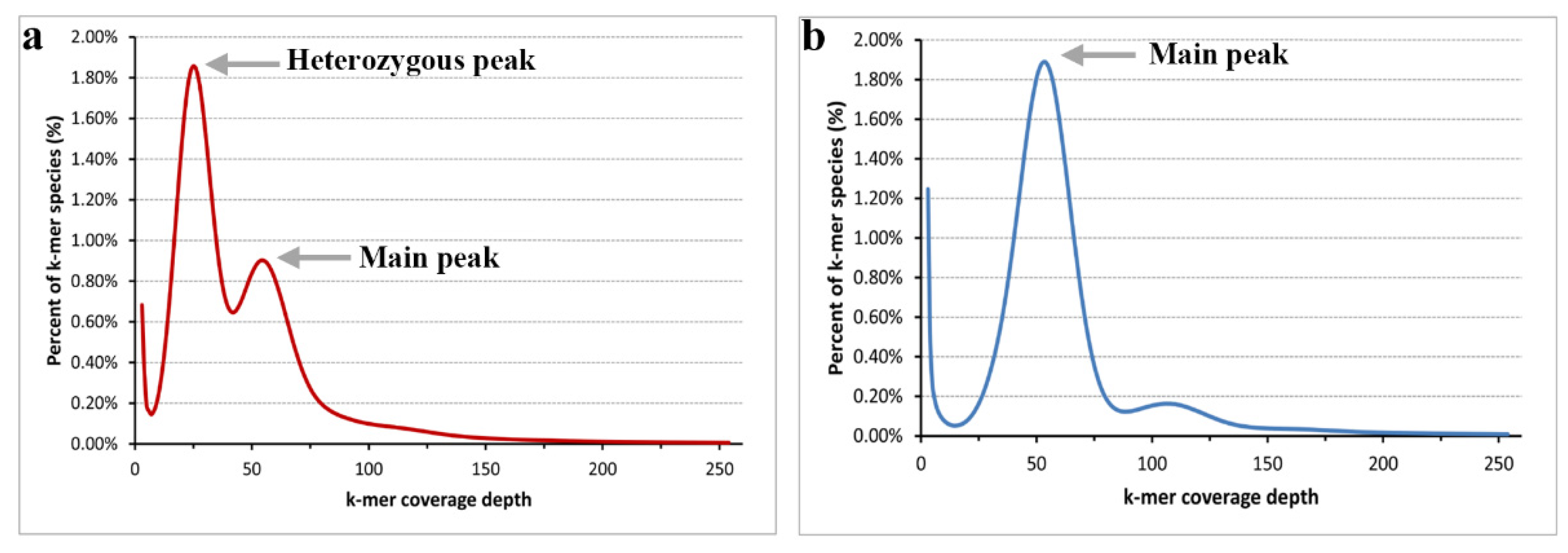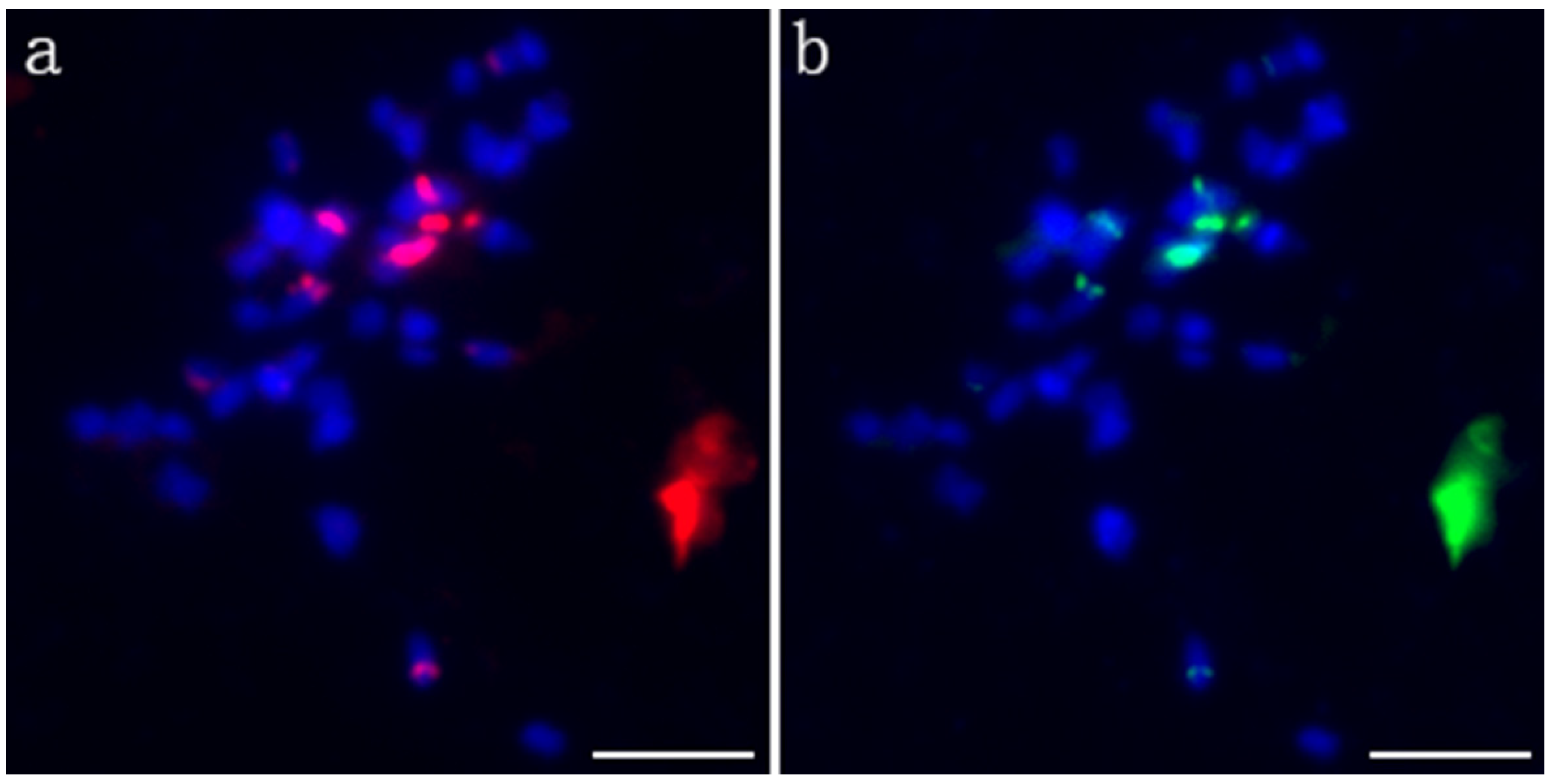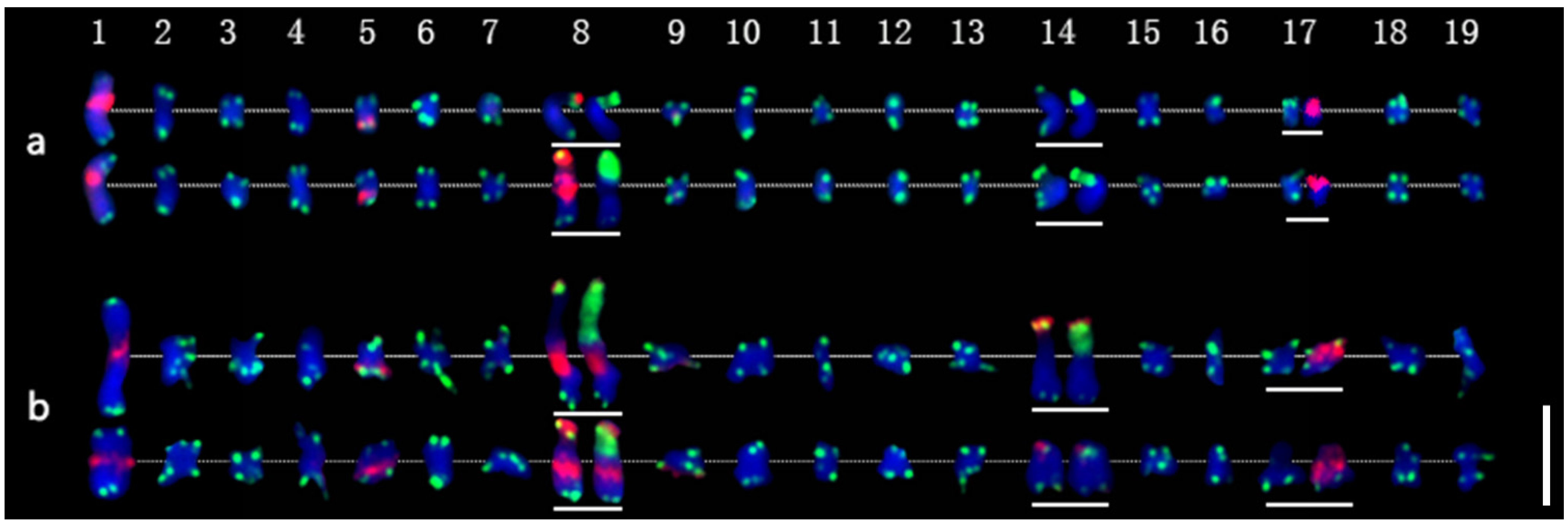Molecular Karyotyping on Populus simonii × P. nigra and the Derived Doubled Haploid
Abstract
:1. Introduction
2. Results
2.1. Homozygosity Assessment by k-mer Analysis
2.2. Development of Repetitive Sequence DNA Probes in P. xiaohei
2.3. The Molecular Karyotype of P. xiaohei
2.4. The Molecular Karyotype of DH
2.5. Karyotype Comparison between P. xiaohei and DH
3. Discussion
4. Materials and Methods
4.1. Plant Materials
4.2. Chromosome Preparation
4.3. k-mer Analysis and Repeat Sequence Recognition
4.4. Probe Labeling
4.5. Fluorescence In Situ Hybridization
5. Conclusions
Author Contributions
Funding
Institutional Review Board Statement
Informed Consent Statement
Data Availability Statement
Conflicts of Interest
References
- He, C.; Zhang, Z.; An, X.; Li, S. Present Situation and Prospect to Poplar Breeding in China. J. Southwest For. Univ. 2006, 4, 86–89. [Google Scholar]
- Zhang, L.; Xi, Z.; Wang, M.; Guo, X.; Ma, T. Plastome phylogeny and lineage diversification of Salicaceae with focus on poplars and willows. Ecol. Evol. 2018, 8, 7817–7823. [Google Scholar] [CrossRef] [Green Version]
- Zhou, J.; Zhang, S.; Wang, J.; Shen, H.; Ai, B.; Gao, W.; Zhang, C.; Fei, Q.; Yuan, D.; Wu, Z.; et al. Chloroplast genomes in Populus (Salicaceae): Comparisons from an intensively sampled genus reveal dynamic patterns of evolution. Sci. Rep. 2021, 11, 9471. [Google Scholar] [CrossRef]
- Shen, Q.; Kang, Z.; Liu, Y. Poplar fine species-Populus simonii × P. nigra. For. Sci. Technol. 1979, 7, 7–8. [Google Scholar]
- Du, Z.; Zhang, T.; Li, S.; Zang, L.; Qu, G.; You, X. Rapid Propagation and Regeneration System of Populus simonii × Populus nigra. Bull. Bot. Res. 2015, 35, 4. [Google Scholar]
- Jiang, Z.H.; Wang, X.Q.; Fei, B.H.; Ren, H.Q.; Liu, X.E. Effect of stand and tree attributes on growth and wood quality characteristics from a spacing trial with Populus xiaohei. Ann. For. Sci. 2007, 64, 807–814. [Google Scholar] [CrossRef] [Green Version]
- Zhou, Y.; Wang, S.; Liu, Y.; Li, K.; You, X. Sequencing and Assembly of Populus simonii × P. nigra Genome and SSR Analysis. Bull. Bot. Res. 2019, 39, 156–160. [Google Scholar]
- Jiang, J.; Gill, B.S. Current status and the future of fluorescence in situ hybridization (FISH) in plant genome research. Genome 2006, 49, 1057–1068. [Google Scholar] [CrossRef] [PubMed]
- Dou, Q.; Yu, F.; Li, Y.; Zhao, Y.; Liu, R. High molecular karyotype variation revealed in indigenous Elymus nutans in the Qinghai Plateau. Plant Divers. 2017, 39, 117–122. [Google Scholar] [CrossRef]
- Blackburn, K.B.; Harrison, J.W.H. A Preliminary Account of the Chromosomes and Chromosome Behaviour in the Salicaceae. Ann. Bot. 1924, 38, 361–378. [Google Scholar] [CrossRef]
- Kang, X. Chromosome Count and Shape of Popular. J. Gansu Agric. Univ. 1996, 1, 67–70. [Google Scholar]
- Chen, C.; Zhang, S.; Li, X.; Han, S.; Song, W.; Qi, L. A comparative study on the karyotypes among sections of populus. Guihaia 2005, 4, 338–340. [Google Scholar]
- Ribeiro, T.; Barão, A.; Viegas, W.; Morais-Cecíli, L. Molecular cytogenetics of forest trees. Cytogenet. Genome Res. 2008, 120, 220–227. [Google Scholar] [CrossRef]
- Islam-Faridi, M.N.; Nelson, C.D.; DiFazio, S.P.; Gunter, L.E.; Tuskan, G.A. Cytogenetic Analysis of Populus trichocarpa—Ribosomal DNA, Telomere Repeat Sequence, and Marker-selected BACs. Cytogenet. Genome Res. 2009, 125, 74–80. [Google Scholar] [CrossRef] [PubMed]
- Hu, B.; Dong, F.; Wang, C.; Qi, L.; Song, W.; Chen, C. Multicolor Fluorescence in Situ Hybridization of Seven Populus Species-ribosomal DNA and Telomere Repeat Sequence. Acta Sci. Nat. Univ. Nankaiensis 2012, 45, 58–64. [Google Scholar]
- Xin, H.; Zhang, T.; Wu, Y.; Zhang, W.; Zhang, P.; Xi, M.; Jiang, J. An extraordinarily stable karyotype of the woody Populus species revealed by chromosome painting. Plant J. 2020, 101, 253–264. [Google Scholar] [CrossRef] [PubMed]
- Younis, A.; Ramzan, F.; Hwang, Y.J.; Lim, K.B. FISH and GISH: Molecular cytogenetic tools and their applications in ornamental plants. Plant Cell Rep. 2015, 34, 1477–1488. [Google Scholar] [CrossRef] [PubMed]
- Rajagopal, J.; Das, S.; Khurana, D.K.; Srivastava, P.S.; Lakshmikumaran, M. Molecular characterization and distribution of a 145-bp tandem repeat family in the genus Populus. Genome 1999, 42, 909–918. [Google Scholar] [CrossRef]
- Prado, E.A.; Faivre-Rampant, P.; Schneider, C.; Darmency, M.A. Detection of a variable number of ribosomal DNA loci by fluorescent in situ hybridization in Populus species. Genome 1996, 39, 1020–1026. [Google Scholar] [CrossRef]
- Braun, A.C. A demonstration of the recovery of the crown-gall tumor cell with the use of complex tumors of single-cell origin. Proc. Natl. Acad. Sci. USA 1959, 45, 932–938. [Google Scholar] [CrossRef] [Green Version]
- Al-Zahim, M.A.; Ford-Lloyd, B.V.; Newbury, H.J. Detection of somaclonal variation in garlic (Allium sativum L.) using RAPD and cytological analysis. Plant Cell Rep. 1999, 18, 473–477. [Google Scholar] [CrossRef]
- Hao, Y.J.; Deng, X.X. Occurrence of chromosomal variations and plant regeneration from long-term-cultured citrus callus. Vitr. Cell. Dev. Biol. Plant 2002, 38, 472–476. [Google Scholar] [CrossRef]
- Bairu, M.W.; Aremu, A.O.; Van Staden, J. Somaclonal variation in plants: Causes and detection methods. Plant Growth Regul. 2011, 63, 147–173. [Google Scholar] [CrossRef]
- Santos-Serejo, J.A.; Aguiar-Perecin, M.L.R. Breakage–fusion–bridge cycles and de novo telomere formation on broken chromosomes in maize callus cultures. Genome 2016, 59, 367–378. [Google Scholar] [CrossRef] [PubMed] [Green Version]
- Bryant, J.A. The cell cycle. In Molecular Aspect of Gene Expression in Plants; Bryant, J.A., Ed.; Academic Press: New York, NY, USA, 1976; pp. 117–126. [Google Scholar]
- Lee, M.; Phillips, R.L. The Chromosomal basis of somaclonal variation. Annu. Rev. Plant Physiol. Plant Mol. Biol. 1988, 39, 413–437. [Google Scholar] [CrossRef]
- Heslop-Harrison, J.S.; Schwarzacher, T. Organisation of the plant genome in chromosomes. Plant J. 2011, 66, 18–33. [Google Scholar] [CrossRef] [PubMed]
- Shi, G.; Thirumalai, D. Conformational heterogeneity in human interphase chromosome organization reconciles the FISH and Hi-C paradox. Nat. Commun. 2019, 10, 3894. [Google Scholar] [CrossRef] [PubMed] [Green Version]
- Zhou, F.; Xu, Y. RepPop: A database for repetitive elements in Populus trichocarpa. BMC Genom. 2009, 10, 14. [Google Scholar] [CrossRef] [PubMed] [Green Version]
- Novák, P.; Neumann, P.; Macas, J. Graph-based clustering and characterization of repetitive sequences in next-generation sequencing data. BMC Bioinf. 2010, 11, 378. [Google Scholar] [CrossRef] [PubMed] [Green Version]
- Novák, P.; Neumann, P.; Pech, J.; Steinhaisl, J.; Macas, J. RepeatExplorer: A Galaxy-based web server for genome-wide characterization of eukaryotic repetitive elements from next-generation sequence reads. Bioinformatics 2013, 29, 792–793. [Google Scholar] [CrossRef] [PubMed] [Green Version]
- Flynn, J.M.; Hubley, R.; Goubert, C.; Rosen, J.; Clark, A.G.; Feschotte, C.; Smit, A.F. Repeat Modeler2 for automated genomic discovery of transposable element families. Proc. Natl. Acad. Sci. USA 2020, 117, 7. [Google Scholar] [CrossRef] [PubMed]
- Liu, C.; Li, K.; Wang, M.; Fan, E.; Yang, C.; Wang, J.; Fu, P.; Ge, X.; Sederoff, H.W.; Sederoff, R.R.; et al. Qu-2, a robust poplar suspension cell line for molecular biology. J. For. Res. 2021, 32, 733–740. [Google Scholar] [CrossRef]
- Dou, Q.; Wang, R.; Lei, Y.; Yu, F.; Li, Y.; Wang, H.; Chen, Z. Genome analysis of seven species of Kengyilia (Triticeae: Poaceae) with FISH and GISH. Genome 2013, 56, 641–649. [Google Scholar] [CrossRef]
- Dou, Q.; Chen, Z.; Liu, Y.; Tsujimoto, H. High frequency of karyotype variation revealed by sequential FISH and GISH in plateau perennial grass forage Elymus nutans. Breed. Sci. 2009, 59, 651–656. [Google Scholar] [CrossRef] [Green Version]
- Fukui, K.; Kamisugi, Y.; Sakai, F. Physical mapping of 5S rDNA loci by direct-cloned biotinylated probes in barley chromosomes. Genome 1994, 37, 105–111. [Google Scholar] [CrossRef] [PubMed]
- Tang, Z.; Yang, Z.; Fu, S. Oligonucleotides replacing the roles of repetitive sequences pAs1, pSc119.2, pTa-535, pTa71, CCS1, and pAWRC.1 for FISH analysis. J. Appl. Genet. 2014, 55, 313–318. [Google Scholar] [CrossRef]





| Name | Length (bp) | Sequences |
|---|---|---|
| pPD349_XHY | 129 | GTCTCTCGTAACCAGAGTCCCGGTTCGAAAGGGCCATAACTTTTGATCCGACCGTTGGATCTCCCTTAAATTTTTACAGGAGTTTCCGGACGCTGTTTTCCTTGGAGTAGATGTGGAATCGCTACTCGG |
| pPC284_XHY | 109 | CGGTTCGAAAGGGCCATAACTTTTGATCCGACCGTTGGATCTCCCTCAAATTTTCACAGGAGTTTCCGGACGCTGTTTTCCTTGGAGTAGATGTTGAATCGCTACTCGG |
Publisher’s Note: MDPI stays neutral with regard to jurisdictional claims in published maps and institutional affiliations. |
© 2021 by the authors. Licensee MDPI, Basel, Switzerland. This article is an open access article distributed under the terms and conditions of the Creative Commons Attribution (CC BY) license (https://creativecommons.org/licenses/by/4.0/).
Share and Cite
Liu, B.; Wang, S.; Tao, X.; Liu, C.; Qu, G.; Dou, Q. Molecular Karyotyping on Populus simonii × P. nigra and the Derived Doubled Haploid. Int. J. Mol. Sci. 2021, 22, 11424. https://doi.org/10.3390/ijms222111424
Liu B, Wang S, Tao X, Liu C, Qu G, Dou Q. Molecular Karyotyping on Populus simonii × P. nigra and the Derived Doubled Haploid. International Journal of Molecular Sciences. 2021; 22(21):11424. https://doi.org/10.3390/ijms222111424
Chicago/Turabian StyleLiu, Bo, Sui Wang, Xiaoyan Tao, Caixia Liu, Guanzheng Qu, and Quanwen Dou. 2021. "Molecular Karyotyping on Populus simonii × P. nigra and the Derived Doubled Haploid" International Journal of Molecular Sciences 22, no. 21: 11424. https://doi.org/10.3390/ijms222111424
APA StyleLiu, B., Wang, S., Tao, X., Liu, C., Qu, G., & Dou, Q. (2021). Molecular Karyotyping on Populus simonii × P. nigra and the Derived Doubled Haploid. International Journal of Molecular Sciences, 22(21), 11424. https://doi.org/10.3390/ijms222111424






